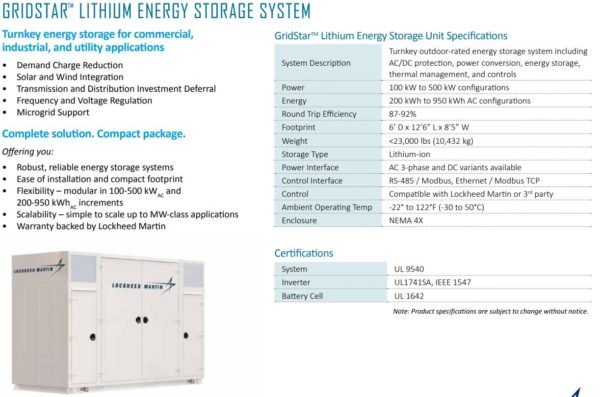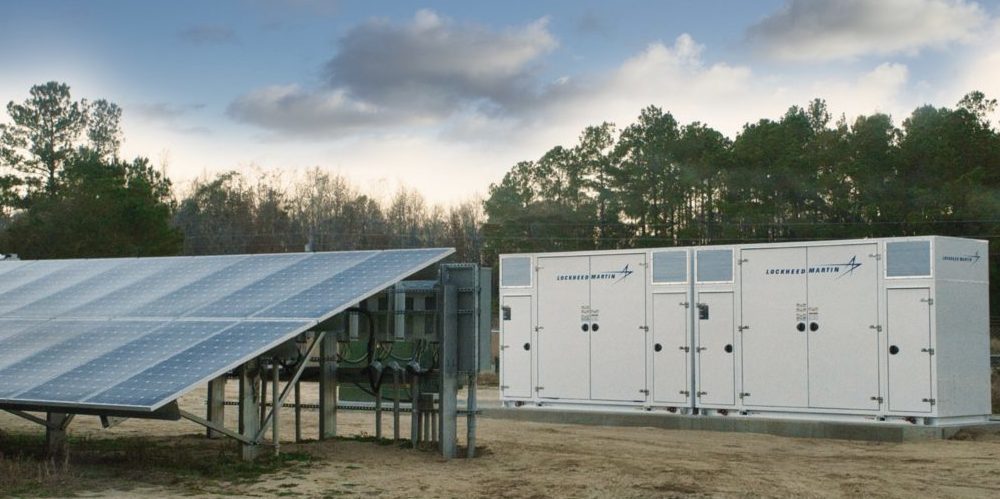Cypress Creek Renewables has commissioned 12 solar power systems coupled with 12 megawatt-hours (MWh) of batteries, as a project that will serve the 100,000 customers of the Brunswick Electric Membership Corporation in south-east North Carolina.
The energy storage hardware is being provided by Lockheed Martin in the form of their 100 kW/200 kWh to 500 kW/950 kWh GridStar Lithium Ion energy storage system (PDF).

The press image provided at the top of this article suggests two Lockheed GridStar units in the particular installation, and if the installations are similarly designed, that would mean 1 MWh total energy storage per installation. That suggests the units deployed might be the 250 kW/500 kWh GridStar variants (if they do in fact have that exact sizing).
The solar panels were supplied by LG – specifically their 395-watt LG NeON® 2 72-cell module. The total number of solar panels was 21,900 – just over 8.6 MW. Spread across 12 sites – that’d mean 720 kW.
Interestingly, the solar panels are a higher priced 19.1% efficient product. Generally, utility scale ground mounts would use a lower efficiency product with a lower price. That these individual installations are only 720 kW each (definitely not individually ‘utility scale’), or that they’re coupled with energy storage and being used for something more than ‘just generation’ could be another reason for using the higher efficiency product. Of course, a group with the engineering resources and volume of projects as Cypress Creek, has definitely value engineered to determine the most cost and mission effective product for the project.
A tweet showed a second project with two GridStar units:
You (hopefully) know that NC is home to a lot of solar. But did you know that we’re at the forefront of solar plus storage, too? @CCRSolar pic.twitter.com/klLvcRQKDj
— Maggie Clark (@mmc_UNC) March 27, 2018
A source told pv magazine that the sizing of these projects will increase their annual output by 5%. This excess electricity generation aligns with project comments that the electricity from the batteries and solar will be used to reduce peak electricity costs and create dispatchable solar resources.
Another major solar power developer is also pushing energy storage heavily into their solar power projects: NextEra and its subsidiary Florida Power and Light.
NextEra has quietly bid the largest energy storage project on the planet. The many hundreds of MWh of energy storage that were bid in conjunction with solar power increased the PPA offering from 2.95¢ per kilowatt-hour (kWh) to 3.6¢/kWh – an increase of only 0.65¢/kWh. This very low price is most likely possible because of the ability to earn additional revenue to that from the power contract during peak periods, by reselling clipped solar electricity at times of higher prices.
Earlier this year, Florida Power and Light announced that they had built a DC-coupled energy storage system specifically to capture clipped solar electricity from DC:AC oversized projects. This project has a 4 MW/12 MWh battery.
In addition to the 12 MWh project, Florida Power and Light also has the current largest solar power plus energy storage project in the U.S. at 74.5 MW-AC plus 10 MW/40 MWh. The DC:AC ratio on this project is 1.65. The heavy DC:AC oversizing means a larger volume of clipping would occur in the high quality Central Florida sunlight – meaning a high probability that this storage system will be capturing that clipped electricity.
This 74.5 MW-AC project by Florida Power and Light is being built in connection with Babcock Ranches – a 100% solar power community in Central Florida. Comparing this project above to Cypress Creek Renewables distributing solar power and energy storage across a smaller electricity cooperative, one must wonder – at what size does a 12 MWh project turn into a cooperative wide ‘microgrid’? And then, at what size is it simply a ‘power grid’ and no longer ‘micro’?
This new solar+storage project comes on the heels of a very active period for Cypress Creek Renewables, which has built 1 GW of solar projects in the 18 months. And this is far from the end – the company has 5 GW of solar PV deployed or in the process of development.
Correction – The article was updated to reflect that the energy storage system were AC-coupled, and not DC-coupled.
This content is protected by copyright and may not be reused. If you want to cooperate with us and would like to reuse some of our content, please contact: editors@pv-magazine.com.









By submitting this form you agree to pv magazine using your data for the purposes of publishing your comment.
Your personal data will only be disclosed or otherwise transmitted to third parties for the purposes of spam filtering or if this is necessary for technical maintenance of the website. Any other transfer to third parties will not take place unless this is justified on the basis of applicable data protection regulations or if pv magazine is legally obliged to do so.
You may revoke this consent at any time with effect for the future, in which case your personal data will be deleted immediately. Otherwise, your data will be deleted if pv magazine has processed your request or the purpose of data storage is fulfilled.
Further information on data privacy can be found in our Data Protection Policy.